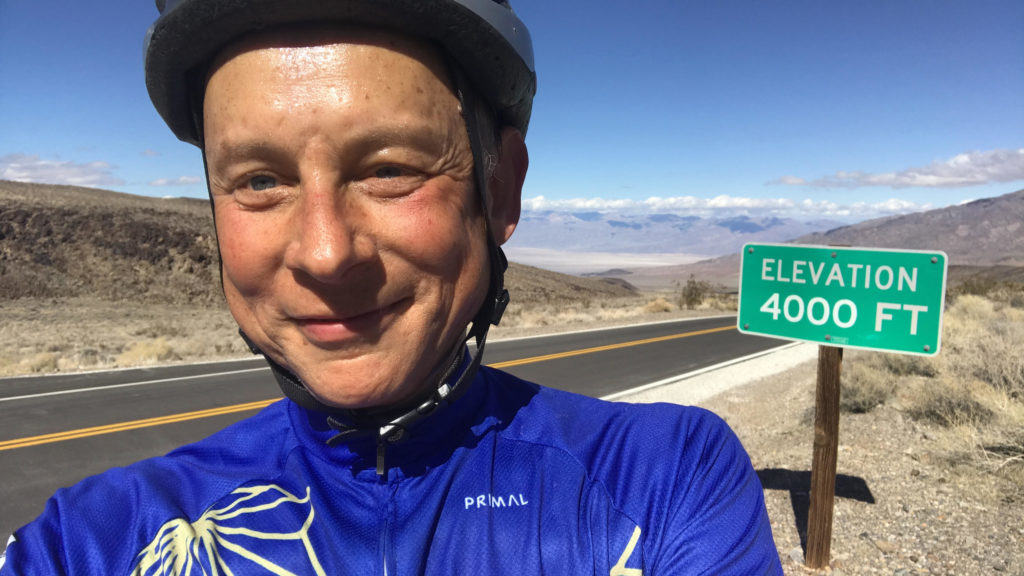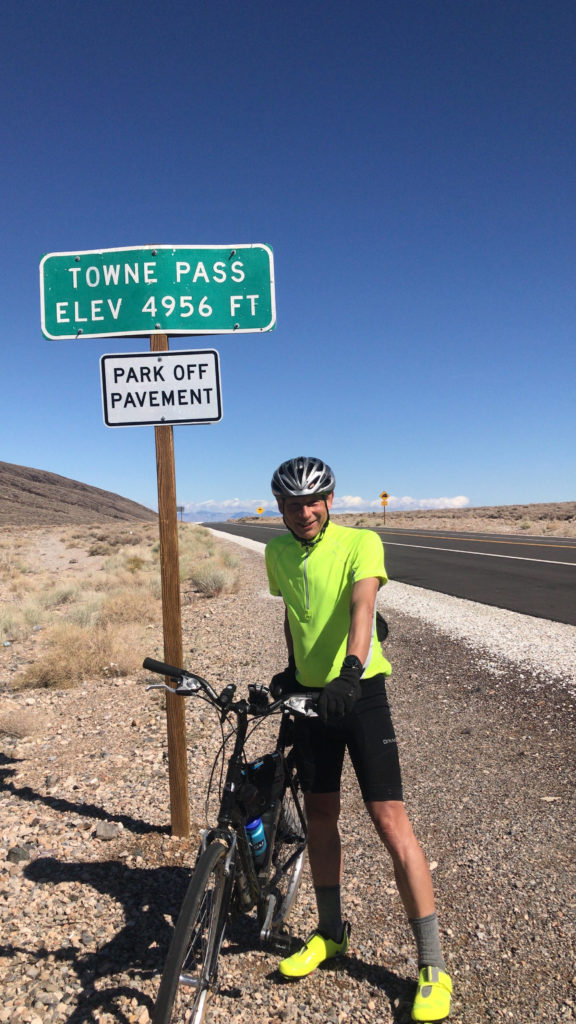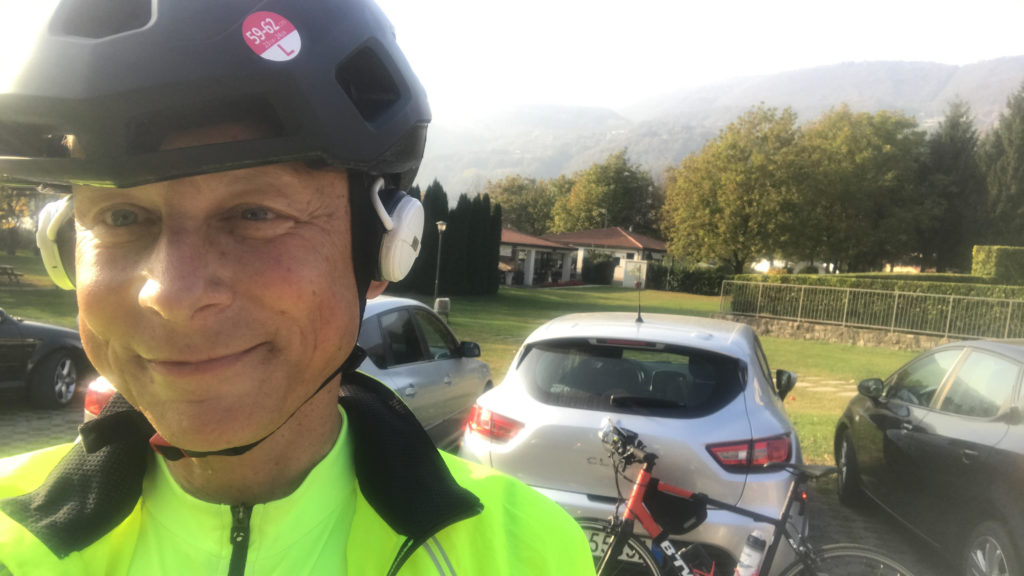 Robert Vogel’s story is about riding for health – both his own personal health and the health of the planet. Personally, Robert finds that cycling seems to be helping him beat cancer – he’s now surpassed the mortality statistics for more than 15 months. For the planet, he likes to believe that the way we tend to the planet reflects how we tend to ourselves and our loved ones.
Vogel’s philosophy is that “We end up helping the planet by gently caring for ourselves and each other – something that Climate Ride seems to embody in the way it organizes these rides.” That view fits right in with Climate Ride, and we feel fortunate that Robert has decided to ride with us. We agree that there is “a really beautiful synergy” in his outlook and our’s. Since he found Climate Ride, Robert is now participating in three events this year.
Robert Vogel’s story is about riding for health – both his own personal health and the health of the planet. Personally, Robert finds that cycling seems to be helping him beat cancer – he’s now surpassed the mortality statistics for more than 15 months. For the planet, he likes to believe that the way we tend to the planet reflects how we tend to ourselves and our loved ones.
Vogel’s philosophy is that “We end up helping the planet by gently caring for ourselves and each other – something that Climate Ride seems to embody in the way it organizes these rides.” That view fits right in with Climate Ride, and we feel fortunate that Robert has decided to ride with us. We agree that there is “a really beautiful synergy” in his outlook and our’s. Since he found Climate Ride, Robert is now participating in three events this year.
Riding to stay healthy and stay alive.
A huge part of Robert’s story is his terminal cancer diagnosis. When he was diagnosed three years ago he sold his company and decided to change his life considerably to take care of his health. That meant doing things he felt were rewarding each and every moment he is alive. He committed to living each moment as fully as possible. He found that was easiest on a bicycle. He knew he needed a physical workout to fight cancer, but for most of his life, Robert had never done any working out. He calls himself more of “a heady person.” But he thought of biking because living in Berkeley he would climb Grizzly peak three or four times a year when he was in his twenties and he knew the Berkely hills are a great place to ride. You can tell he loves them if you get the chance to hear him describe “The light, the fog, the views of the East Bay, and right in my backyard. I fell in love with riding in the Berkeley hills.” Since hopping on his bike, he’s been getting stronger slowly. But it also helps to keep him living in the moment. He likes how on a bike, “you never know what the weather will be like, what’s around the next curve, who you’re going to meet. I’m totally in the moment when I’m on the bike.” He believes he is doing great because of his attitude and his bike riding. He rides to stay healthy and stay alive.Sharing his story also helps Robert fight the disease.
 Robert believes in change by setting a good example. That’s why he tells his story. It seems to resonate and show people that the more we model taking good care of ourselves to other people, the more we inspire them to do the same.
Robert has been doing something a little extra his whole life. He always felt like he wanted to do his part in making the world a better place. Fifteen years ago he started Peak Democracy to help facilitate consensus building in communities on important issues. His clients were local governments, usually in the midst of conflict over big issues. His company helped to bring resolution and avoid confrontational politics.
He’s tried to do his part his whole life in many different ways and always believed that there’s a very close connection between our ability to take care of ourselves and our ability to take care of the planet. So when Robert first heard about Climate Ride Death Valley from his wife, it sounded like a fantastic fit and a fantastic ride. He had visited Death Valley and loved it and he wanted to see it from the saddle of a bike.
He also liked that he could choose from Climate Ride’s beneficiary list to support the Nature Conservancy, an organization that shares in his non-confrontational philosophy and works in coordination with private landowners to protect wilderness and conduct science-based research. Before Climate Ride he had never fundraised before, though he had donated.
He had also mostly biked solo but wanted to ride with other people. Having contacted several other biking groups, Climate Ride was the first organization that was encouraging when he mentioned that he was undergoing hormone therapy, which makes him less strong and slightly anemic. When he rides with others, he’s found that even though he trains intensively, he can’t keep up due to the anemia. With its full support, Climate Ride likes to make sure anyone who wants to can ride for the planet. To do that, we attempt to have some backup vehicles so that at strategic points on the route we can catch people up if need be.
For Robert, it was the opportunity he was looking for – to ride with people and help the planet. He said of his time on the ride that “They just took care of me. Fantastic ride, fantastic opportunity. So I signed up for two more. I don’t know if I’m going to be able to do anything after a few months so I got to do it now.”
Robert believes in change by setting a good example. That’s why he tells his story. It seems to resonate and show people that the more we model taking good care of ourselves to other people, the more we inspire them to do the same.
Robert has been doing something a little extra his whole life. He always felt like he wanted to do his part in making the world a better place. Fifteen years ago he started Peak Democracy to help facilitate consensus building in communities on important issues. His clients were local governments, usually in the midst of conflict over big issues. His company helped to bring resolution and avoid confrontational politics.
He’s tried to do his part his whole life in many different ways and always believed that there’s a very close connection between our ability to take care of ourselves and our ability to take care of the planet. So when Robert first heard about Climate Ride Death Valley from his wife, it sounded like a fantastic fit and a fantastic ride. He had visited Death Valley and loved it and he wanted to see it from the saddle of a bike.
He also liked that he could choose from Climate Ride’s beneficiary list to support the Nature Conservancy, an organization that shares in his non-confrontational philosophy and works in coordination with private landowners to protect wilderness and conduct science-based research. Before Climate Ride he had never fundraised before, though he had donated.
He had also mostly biked solo but wanted to ride with other people. Having contacted several other biking groups, Climate Ride was the first organization that was encouraging when he mentioned that he was undergoing hormone therapy, which makes him less strong and slightly anemic. When he rides with others, he’s found that even though he trains intensively, he can’t keep up due to the anemia. With its full support, Climate Ride likes to make sure anyone who wants to can ride for the planet. To do that, we attempt to have some backup vehicles so that at strategic points on the route we can catch people up if need be.
For Robert, it was the opportunity he was looking for – to ride with people and help the planet. He said of his time on the ride that “They just took care of me. Fantastic ride, fantastic opportunity. So I signed up for two more. I don’t know if I’m going to be able to do anything after a few months so I got to do it now.”
There are all sorts of good reasons to ride your bike.
But one of the best reasons is getting to visit incredible places for a good cause with people like Robert. During Climate Ride Death Valley, he took a moment to update his friends and family about his ride. Graciously, he shared that update with us, and it really captures the sort of experience many riders have: It is 3 AM on Tuesday morning. I am enjoying an enclave of ‘civilization’ at Furnace Creek which has decent Internet, a good bed and space for stretching, yoga, meditation, and writing. I’m exploiting all of it to prepare for the second half of our ride, as we go back into the stark desert later this morning. Yesterday (Monday) was one of the most intense, exhilarating days of my life. The pictures I shared with you do not capture the intensity of my experience – which I want to share with you now in words. I approached yesterday’s ride with some anxiety. The 3,500-foot climb at the beginning has the steepest grade (up to 11%) of all our climbs on this 4-day trip. I did not know if I would be able to make it. For me, the climb turned out to be an intense 3.5 hours of physical, intellectual and emotional focus, unlike anything I had experienced in my life. On the one hand, I needed to sustain sufficient power & speed to keep from falling over – a frightening prospect when you are clipped into your pedals, cycling the thin line between rocks and traffic. On the other hand, I knew that if I over-exerted early in the ride, I would become exhausted later and not have sufficient strength to make it to the top. I have a bike computer on my handlebar which displays crucial data: my heart rate, power, cadence, and radar which shows the presence of traffic behind me. From experience, given the grade, I know the heart rate, power, and cadence I am capable of sustaining. So, my focus rotated between the numbers on my computer, the physical sensations in my body, the sounds of traffic, and oh yes … the stunning views of which you have seen a few glimpses. Underlying all of this was my deep conviction that having a strong physical body will keep my cancer at bay. For me, this was a climb to stay alive. Making it to the top was a great satisfaction. The transition from climb to descent was shocking. I went from a 3.5 hour, 4mph grueling pace to a 35mph downhill that lasted nearly 30 minutes. This, too, was unlike anything I had experienced in my life: a well-paved road that stretched down forever into Death Valley. The wind, the gentle up/down accelerations of the small rollers on the way down, the magnificent view, the beating of my own heart – not from exhaustion but from exhilaration, defy description. When I joined my friends for lunch at the bottom I told them I felt like the space shuttle re-entering the earth’s atmosphere (something I’ve wanted to experience my whole life). So my friends … thank you for letting me share these words with you… and for all the support and encouragement you’ve shared with me. What an exquisite experience it has been so far, and I wish to share this beauty with you as much as I can.Thank you, Robert, for helping us to live in the moment.
